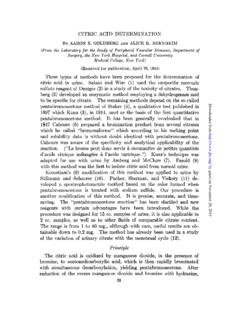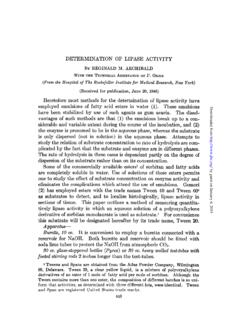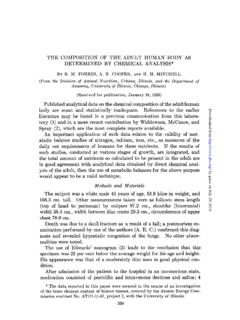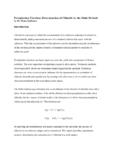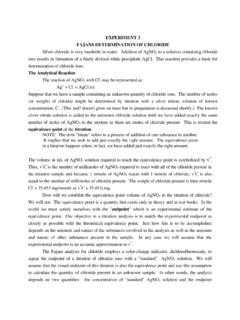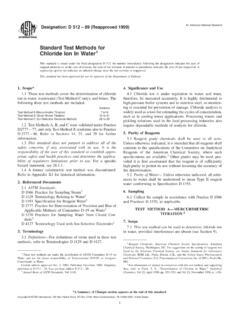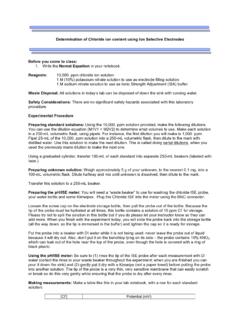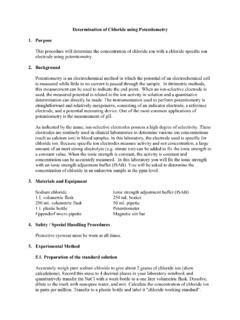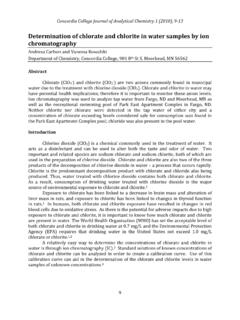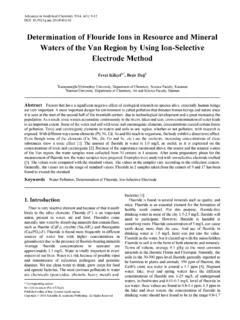Transcription of VOLUMETRIC DETERMINATION OF CALCIUM IN
1 VOLUMETRIC DETERMINATION OF CALCIUM IN BLOOD SERUM 13~ WILLIAM E. ELLIOTT (Prom the Research Laboratories, Allis-Chalmers Manujacturing Company, Milwaukee, Wisconsin) (Received for putdication, Dcccmbcr 10, 1951) CALCIUM in blood serum is usually by precipitation which involve careful handling techniques. The Clark-Collip (1) modifi- of the Krnmcr-Tisdall (2) method has been a standard practice. It is based on the precipitation of CALCIUM oxalate and titration with potas- sium permanganate. Roe and Kahn (3) developed an indirect deter- mination by precipitating CALCIUM and determining colori- metrically the phosphate present in the precipitate.
2 These techniques are accnratc in the hands of trained analysts, but 2 to 24 hours are required for the A simple, rapid, and accurate procedure is greatly to be desired. In the past 2 years, mater laboratories have almost universally adopted methods for CALCIUM DETERMINATION based on the work of Schwarzen- bath et al. (4) on the formation of complexes of alkaline earth metals with disodium dihydrogen ethylenediamine t,etraacetatc. The adaptation of this reagent to water analysis was made largely by Diehl et al. (5) and B&z and No11 (6). Sobel and Hanok (7) have investigated the use of the dye eriochrome black T as an indicator for the DETERMINATION of CALCIUM plus mag- nesium in blood serum, using disodium dihydrogen ethylenediamine tetra- acetate as chelating agent.
3 This is carried out in a buffered solution at pII to However, at pH 12 ammonium purpurate is a specific indicator for CALCIUM , and magnesium does not interfere. This has been shown by Rctz and X011 (A) and is a well established procedure in water analysis. Greenblatt and Hartman (8) have suggested a method for determining CALCIUM in very small samples, using a micro burette. However, the average would be ml. and calculations are more involved. For simplicity, accuracy, and ease of calculation the macromethod de- scribed below has advantages in the hands of technicians and involves no expensive equipment.
4 The procedure to be described for the DETERMINATION of CALCIUM in blood serum is a modification of the method for DETERMINATION of CALCIUM in water. by guest on June 8, 2020 from 642 DETERMIKATION OF CAL( II:M IN SERUM Reagents- RXPERIMESTAL Disodium dihydrogen ethylenediamine , analytical reagent, grade, Bersworth Chemical Company, Framingham, Massachusetts. Ammonium purpurate, CALCIUM indicator, was obtained in capsule form from t,he Hagan Corporation, Pittsburgh, Pennsylvania. To pre- pare the indicator the content,s of one capsule were suspended in 30 ml. of distilled water.)
5 The indicator was stored in an amber bottle and fresh indicator was prepared every 3 to 4 weeks, because ammonium purpurate is unstable. A 9 N solution of analytical reagent grade sodium hydroxide is used as a buffer to adjust the sample to approximately pH 12. CALCIUM carbonate, analytical rcagent grade. Hydrochloric acid, analytical reagent grade. Standardization Procedure--The disodium dihydrogcn ethylenediamine tetraacetate titrating solution is made N by standardization with CALCIUM carbonate. It is prepared by dissolving approximately gm. of reagent grade d&odium dihydrogen ethylenediamine tetraacetate in a small volume of CALCIUM -free distilled water and diluting this solution with CALCIUM -fret distilled water to 1 liter in a VOLUMETRIC flask.
6 This solution is standardized against a standard CALCIUM solution so that 1 ml. is equal to mg. of CALCIUM . A standard CALCIUM carbonate solution is prepared with reagent grade CALCIUM carbonate dried at lOSo for 24 hours. A sample of this CALCIUM carbonate weighing gm. is placed in an evaporating dish and dis- solved in 1 ml. of concentrated hydrochloric acid. This solution is care- fully evaporated to dryness and the CALCIUM chloride formed is dissolved in a small amount of CALCIUM -fret distilled water. It should be carefully transferred to a 1 liter flask and diluted to the mark.
7 This solution is used as a stock solution; 20 ml. of the stock solution are diluted to volume with CALCIUM -free distilled water in a 200 ml. VOLUMETRIC flask. This solution contains mg. of CALCIUM per ml. By means of a pipette, a 50 ml. sample of the CALCIUM chloride solution containing mg. of CALCIUM per ml. is placed in a 250 ml. Rrlenmeyer flask. ml. of the 9 N NaOH solution and 1 to 2 drops of ammonium purpurate indicator arc added. The indicator is cherry-red in t,he pres- ence of CALCIUM . The sample is titrated with the approximately N disodium dihydrogen ethylenediaminc tetraacetate solution to the purple end-point.
8 Unknown samples should be titrated to the same purple end- point reached in titrating a blank. To facilitate calculations the of the titrating solution should bc adjusted so that 20 ml. are exactly equivalent to a 50 ml. sample of the standard CALCIUM chloride solution. by guest on June 8, 2020 from W. E. ELLIOTT 643 Procedure for CALCIUM in Blood Serum-A ml. sample of clear blood serum is transferred by means of a pipette to a 250 ml. Erlenmeyer flask. The sample is diluted to 50 ml. with CALCIUM -free distilled water. ml. of 9 N KaOH solution and 1 drop of ammonium purpurate indicator are added.
9 The indicator should be prepared every 3 weeks, because it is unstable. TABLE I CALCIUM Recovery Results in mg. per cent of Ca per 100 ml. of serum. Sample No. CALCIUM in blood serum .- 1 2 3 4 5 6 7 8 9 10 11 12 13 14 15 16 17 18 19 20 CALCIUM after addition of mg. of Ca per 100 ml. 21 .o - TABLE II Comparison of Serum CALCIUM Determinations Results in mg. per cent of Ca per 100 ml. of serum. Difference Sample No. Clark-Collip method (I) New method ----- - 1 2 3 4 5 6 7 8 -- by guest on June 8, 2020 from 644 DETERMINATION OF CALCIUM IN SERUM The sample is rapidly titrated with constant swirling to the same purple end-point reached in a titrated blank.
10 Calculation-1 ml. of the titrating solution is equivalent to 1 mg. per cent of CALCIUM per 100 ml. of blood serum. Analytical titration of the CALCIUM in each of twenty blood serum samples, increments containing mg. of CALCIUM were added to see whether the recovery of CALCIUM would be complete. These results are listed in Table I. Further tests were run to check the new method against standard pro- cedures. The Clark-Collip (1) method with a potassium permanganate titration of CALCIUM oxalate was selected as the most universally accepted procedure. Blood serum CALCIUM was determined by both methods.
